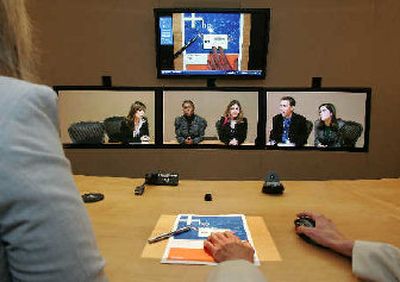Now they have room to talk

PALO ALTO, Calif. — Hewlett-Packard Co. on Monday jumped into the business of providing the technology — and building the rooms — for large companies to hold virtual face-to-face meetings regardless of the distance between participants.
HP’s Halo Collaboration Studio offers a nearly immersive environment where people can see each other, talk and collaborate remotely as if they were in the same room. The underlying network, built and serviced by HP, minimizes delays and never crosses the public Internet.
Developed in partnership with DreamWorks Animation SKG LLC, the rooms are targeted at large corporations that are looking to cut down on the amount of time and money spent flying people to different locations. Each room costs roughly $550,000 with an $18,000 per month fee though the charges vary with the number ordered.
The idea originated in the aftermath of Sept. 11 as airlines cut back on flights, security was ratcheted up and travel became more of a time-consuming headache, said Jeffrey Katzenberg, the DreamWorks Animation’s chief executive.
“We found ourselves with the inability to move creative talent around to sites we have around the country,” he said from Manhattan while participating in a demonstration videoconference with Palo Alto. “It actually put a damper on our ability to have the right people at the right time.”
DreamWorks Animation helped design the details of the rooms and will receive a royalty. Other financial details between the two companies were not disclosed.
Video conferencing rooms, however, are not unique. Teliris Ltd., which was founded in 2002, also builds rooms and provides the technology for a number of large companies. In November 2004, it issued a news release announcing that DreamWorks Animation is one of its customers.
“What HP is showing today is two generations older than our current rooms,” said Marc Trachtenberg, Teliris’ chief executive and founder. “Our rooms are more technically sophisticated, more capable than their rooms and our cost is much less than theirs.”
Teliris’ charges less than half of what HP does, he said.
HP counters that it’s building a better experience than the competition and a technology that can grow.
“We’re making investments up front to allow us to build a powerful system that will scale with the business very easily,” said Stephen Nigro, general manager of HP’s Imaging and Printing Technology platforms.
In HP’s rooms, up to six users in one location sit at a table and face their colleagues, who appear on three 50-inch plasma screens. Video cameras are located in holes near the screens so it appears that people are looking into the eyes of their colleagues when talking.
A fourth monitor, positioned above the three, can be used to display the screen of a shared computer or display an object placed on the conference table over a camera in the ceiling.
Strategically placed speakers and microphones give the sense that voices are coming from the area of the room where the speaker is sitting.
The system is controlled with a standard computer mouse, and the rooms can be hooked up so that meeting participants can access the Internet or the corporate network via the laptops they bring with them.